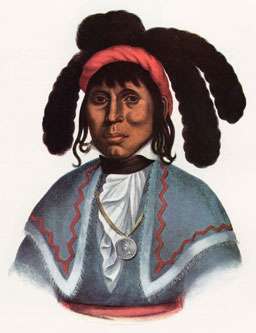Micanopy

Micanopy (c. 1780 – January 2, 1849), also known as Micco-Nuppe, Michenopah, Miccanopa, Mico-an-opa and Sint-chakkee ("pond frequenter", as he was known prior to accession),[1] was the leading chief of the Seminoles who led the tribe during the Second Seminole War.
Biography
His name was derived from the Hitchiti "miko" (chief), and "naba" (above), and consequently meaning "high chief" or the like.[1] Micanopy was also known as Hulbutta Hajo (or "Crazy Alligator").
Although little is known of his early life, Micanopy was born near present-day St. Augustine, Florida, sometime around 1780. He succeeded Bolek as hereditary principal chief of the Seminole following his death in 1819; Micanopy soon began acquiring large amounts of land and cattle. As was common practice among elite Seminole, he hired more than 100 fugitive slaves to work his estates during the early nineteenth century. He encouraged intermarriage between the Seminole and blacks. Some of their descendants gained influence as an elite among tribal councils (including several war chiefs).
Following the American purchase of Florida from Spain in 1819 through the Adams–Onís Treaty, and the subsequent appointment of Andrew Jackson as territorial governor in 1821, large numbers of American settlers began colonizing northern Florida during the next decade. Micanopy opposed further American settlement of the region. As conflicts arose more frequently between the Seminole and settlers, the Seminole were driven away from the Florida coast and into the extensive wetlands of the interior. By the Treaty of Moultrie Creek in 1823, the Americans seized 24 million acres of Seminole land in northern Florida, and the Seminole moved to central and southern territory.
Slaveholders from Florida and neighboring states demanded that the Seminole capture and return slaves who had taken refuge with them. American development of large plantations in Florida led to planters buying more slaves, only to see some escape. With pressure continuing against the tribe and Americans calling for removal following passage of the Indian Removal Act, a group of Seminole chiefs eventually agreed to the Treaty of Payne's Landing in 1832; they ceded more Seminole lands in exchange for reservations in the Indian Territory (present-day Oklahoma) on May 9, 1832.
Negotiating a peaceful resolution between the Seminole and local authorities, Micanopy refused to sign the treaty. He joined younger chiefs, such as Osceola, Alligator and Wild Cat (a nephew of Micanopy), in opposing the treaty. They began to organize resistance among the Seminole warriors. Following Osceola's murder of the US Indian agent General Wiley Thompson, Micanopy (with Osceola) attacked forces under Major Francis Langhorne Dade and General Duncan Lamont Clinch in December 1835. Only three soldiers survived what the Americans called Dade's Massacre, contributing to calls for US military action against the Seminole, and the beginning of the Second Seminole War.
The Seminole had early success, but the elderly Micanopy became convinced of the futility of war against the large numbers of American soldiers. He surrendered in June 1837 and began negotiating to move his tribe to the Indian Territory, but he was kidnapped by Osceola. In December 1838, Micanopy was captured by General Thomas S. Jesup's forces while under a flag of truce, when he had already agreed to sign a peace treaty. This breach of honor by the US was considered an outrage by much of the public, increasing their sympathy toward the Seminole.
Imprisoned at Charlestown, South Carolina, Micanopy was eventually released and sent with around 200 other Seminole to Indian Territory. They were initially put under Creek Nation authority, although the people had long been independent.
Although Micanopy attempted to reestablish the Seminole as independent, he never regained his previous power. In 1845, he was one of the signatories of a treaty with the US, which gave the Seminole of western Florida semi-independence from the Creek Nation in Indian Territory, with full Seminole independence to be granted in 1855. He died at Fort Gibson on January 2, 1849.
Micanopy was succeeded in the matrilineal line by his sister's son, Jim Jumper, as principal chief, as the Seminole had gradually re-established their italwa and traditional organizations in Indian Territory. Jim Jumper was succeeded after his death four years later by his brother, John Jumper, who led the tribe until after the American Civil War. At that time, United States intervention in tribal affairs complicated the succession.
Legacy and honors
European Americans named Micanopy, Florida after him;[2] it was founded at the site of the chief's capital town, Cuscowilla.
Notes
- 1 2 Simpson, J. Clarence (1956). Mark F. Boyd, ed. Florida Place-Names of Indian Derivation. Tallahassee, Florida: Florida Geological Survey.
- ↑ Frisaro, Freida Ratliff (Feb 21, 1988). "Indian heritage runs deep throughout Central Florida". Ocala Star-Banner. p. 63. Retrieved 6 June 2015.
References
- Johansen, Bruce E. and Donald A. Grinde, Jr., The Encyclopedia of Native American Biography, New York: Henry Holt and Company, 1997.
- Markowitz, Harvey., ed., Magill's Choice American Indian Biographies, California: Salem Press Inc., 1999.
- Sattler, Richard A. "The Seminole in the West", Handbook of North American Indians:Southeast, Vol. 14, ed. William Sturtevant, Washington, DC: Smithsonian Institution, 2004
External links
| Preceded by Bolek |
Leading chief of the Seminoles 1819–1849 |
Succeeded by ? |